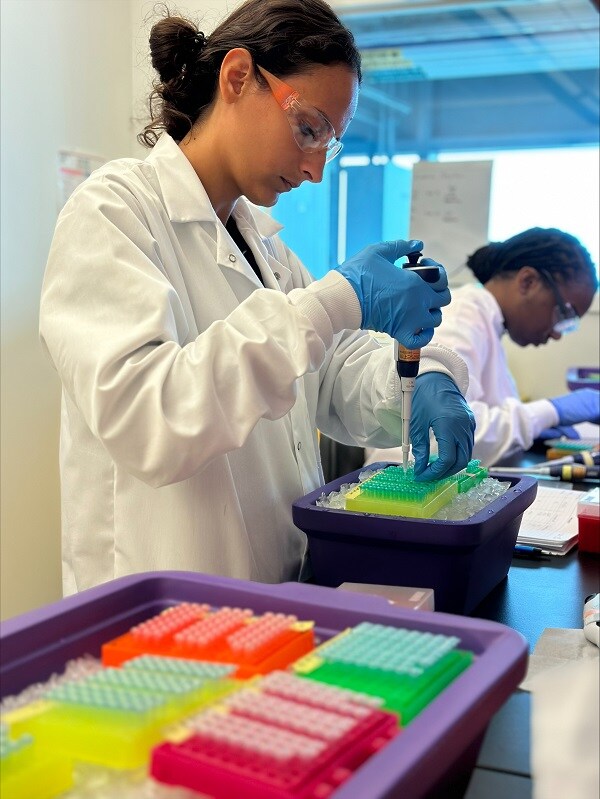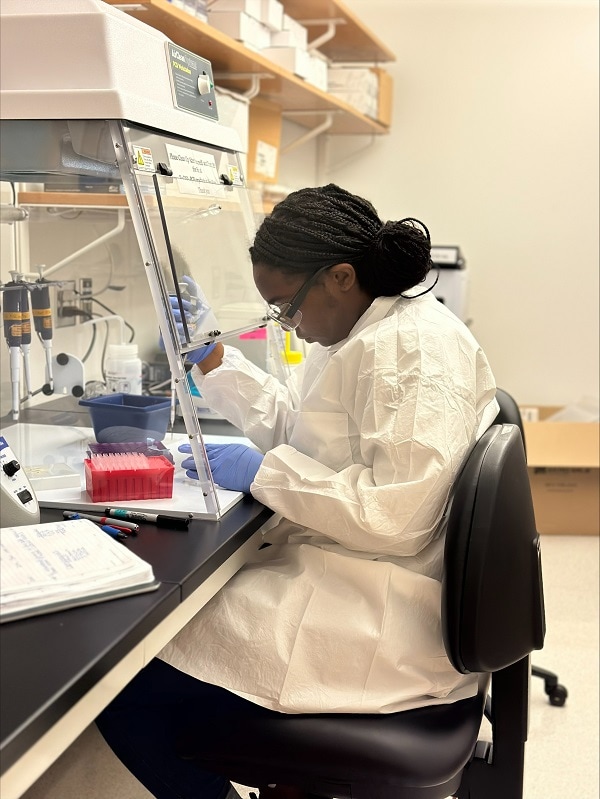World Malaria Day Feature 2024: The Threat, the Tech, and the Team
Every April 25, CDC joins the global community to highlight malaria, a serious parasitic disease spread to humans by a certain type of mosquito, Anopheles. Malaria remains a leading cause of preventable illness and death in the world. In 2022, there were approximately 249 million malaria cases and 608,000 malaria deaths in 85 countries. Malaria disproportionately impacts women and young families, with children under five making up approximately 80% of malaria deaths and pregnant women facing severe health outcomes. Africa carries the largest burden, accounting for approximately 94% (233 million) malaria cases and 95% (580,000) malaria deaths.
CDC continues to be a global leader in malaria work, with our state-of-the-art insectary and entomology labs providing a platform for innovative research to address malaria’s threat. This past summer, a team from CDC’s Division of Parasitic Diseases and Malaria (DPDM)’s Entomology Branch created an innovative, simple, and accessible loop-mediated isothermal amplification (LAMP) assay for molecular identification of the invasive malaria vector Anopheles stephensi.
The team, led by molecular biologist Cristina Rafferty, included two interns from Summer 2023 through the Public Health Entomology for All (PHEFA) program:
- JeNiyah Scaife
- Gloria Raise
Understanding Anopheles stephensi (The threat)
Anopheles stephensi (An. stephensi) is a malaria vector native to South Asia but has since spread to Africa and poses a huge threat to the malaria landscape. In Africa, An. stephensi was first detected in Djibouti, a country that was on the cusp of malaria pre-elimination status in 2012 with only 27 presumed or confirmed cases. In 2020, malaria cases had reached more than 73,000, with many believing it was due to An. stephensi. On the African continent, the vector has also been detected in Sudan, Somalia, Eritrea, Ethiopia, Kenya, and more recently Nigeria and Ghana. If the spread continues, estimates predict it could put an additional 126 million people per year at risk of malaria, mostly in peri-urban/urban areas.
An. stephensi is also different from typical African malaria vectors; it’s both urban and peri-urban as opposed to typical rural vectors, has different feeding behaviors, can breed in man-made containers, and is not seasonal, thus having the potential to transmit malaria year-round. It is also resistant to common insecticides. These attributes make the most common malaria vector interventions (e.g., indoor residual sprays and insecticide-treated nets) less effective against An. stephensi.
Access to fast and accurate molecular tools is integral in confirming the presence of An. stephensi in new locations. This is because it can be difficult to distinguish from other vectors morphologically. Up until now, there were no easily accessible molecular tools to rapidly detect invasions of An. stephensi, leading to significant challenges to early detection as it continues to spread across Africa.
Creating an accessible assay (The tech)
This past summer, CDC’s team created a rapid colorimetric loop-mediated isothermal amplification assay for An. stephensi species identification, referred to as the CLASS assay. The team worked tirelessly rearing mosquitoes, conducting DNA extraction, analyzing PCRs and gels, and testing with different reagent concentrations at different times and temperatures. The team kept accessibility and field-friendliness at the forefront when designing the assay. Teams utilizing this assay do not need a full molecular laboratory nor highly trained molecular biologists to interpret the assays, which addresses major barriers that currently exist in the field.
Creating innovative tools to detect malaria vectors such as An. stephensi is key to global malaria control and elimination. Utilizing the CLASS assay will not only help with early detection and accurate identification of An. stephensi, but also further informs researchers on the changing malaria landscape and how to best prepare and rapidly respond.
A pre-print describing the CLASS assay is available now. Malaria programs have started to pilot the CLASS assay in countries, including Kenya, Ghana, Ethiopia, and Tanzania. The countries are using the assay for screening in the field, with additional follow up as necessary. The CDC team will gather valuable feedback from countries, further informing researchers about its use.

Gloria Raise, currently a senior at New Jersey Institute of Technology, works in the lab and pipets during the PHEFA internship.
Investing in a diverse entomology workforce (The team)
Two PHEFA interns, JeNiyah Scaife and Gloria Raise, under the mentorship of molecular biologist Cristina Rafferty, conducted much of the lab work that supported optimizing the CLASS assay. PHEFA, a joint program between the Entomological Society of America (ESA) and CDC, aims to expand and diversify the pool of scholars interested in and entering the public health entomology field. Scaife and Raise attend undergraduate institutions that take deliberate steps to recruit, enroll, and retain students from underrepresented populations. They both completed a rigorous application and interview process before being selected by DPDM. Though the students were rising seniors majoring in forensic science, they each wanted to learn more about entomology.
“[…] a lot of people don’t even know what entomology is; there’s very few schools that have an entomology program, so I guess the aim of the program is to show that there is entomology connected with public health […] it kind of shows what the power of entomology can have, and the impact it can have on people’s health and lives,” says Raise.
In addition to learning more about the field, the direct experience was invaluable. “I learned more in 10 weeks than I’ve learned in an entire semester at school,” says Scaife. “As far as using some of the instruments in the lab, I feel more confidently when it comes to running PCRs, or using the thermal cycler, or running a gel; I feel like I know it like the back of my hand. I looked forward to going to the lab every morning to see what we could get done throughout the day or something new I was going to learn.” Exuding pride, Rafferty, who mentored these students, said, “not only did they help to change the course of how the world can detect An. stephensi, but they also gave me hope in there being a more diverse and ready public health entomology workforce.”

JeNiyah Scaife, currently a senior at Fayetteville State North Carolina, works in the lab during the PHEFA internship.
As malaria continues to evolve as a global threat to human health, we must continue to invest in innovative approaches to detect, prevent, control, and one day, eliminate it. These approaches require diverse and inclusive thinking. Efforts like PHEFA interns working to optimize and develop the CLASS assay is a keystone example of why such methods are paramount in public health. DPDM is proud to have talented individuals with diverse backgrounds and experiences contributing to innovative work that improves how CDC can address emerging public health threats, ultimately protecting the lives and livelihoods of the most vulnerable.